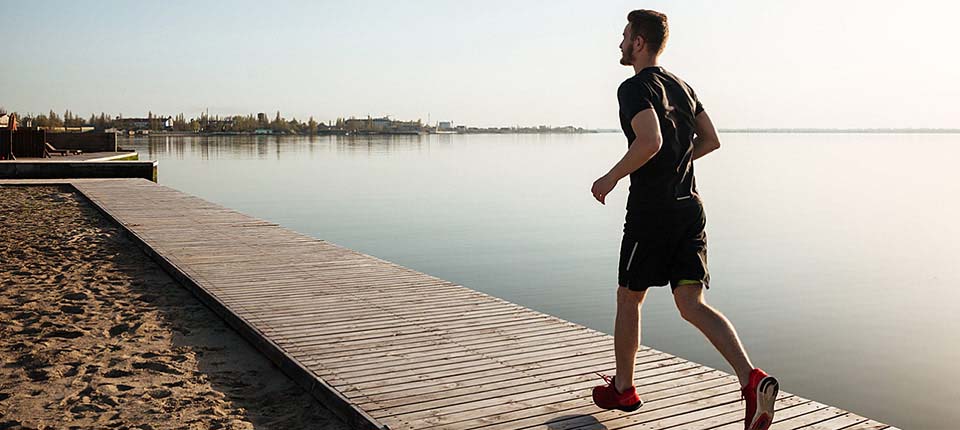
Cardiovascular Fitness: What It Means to Your Heart Health
Learn more about cardiovascular fitness and what it may reveal about your health.
Oct. 05, 2017
- Copy Link
- Share on X
- Share on Facebook
- Share on Linkedin
Everyone's familiar with routine vital signs measured at the doctor's office. Blood pressure? Check. Pulse rate? Check. Temperature? Check.
But did you know there's a vital sign that could be just as essential to evaluating your heart health? Your cardiovascular fitness level can have as big of an impact on your health as factors such as smoking, hypertension and high cholesterol, according to the American Heart Association (AHA). A simple fitness test may provide key insights into your cardiovascular health.
Cardiovascular Fitness as a Vital Sign
Your cardiovascular fitness, also called your cardiorespiratory fitness (CRF), says a lot about your health and the potential for health outcomes. Simply put, CRF measures how well your body takes in oxygen and delivers it to your muscles and organs during prolonged periods of exercise.
Generally, the higher your CRF level, the lower your risk for developing a variety of conditions.
For example, low levels of CRF are associated with a high risk of cardiovascular disease, certain cancers and higher mortality rates, according to the AHA.
The growing link between CRF and overall health led the AHA in 2016 to recommend measuring cardiorespiratory fitness during routine clinical visits as part of a regular health assessment. The AHA found:
- Cardiovascular fitness level is linked to heart failure risk and the likelihood of heart failure hospitalization later in life.
- Low CRF is a strong predictor of the risk of stroke.
- Optimizing CRF prior to surgical interventions may improve outcomes, including surgical risk, mortality and the ability to function after surgery.
An Important Check During Checkups
Adding CRF to traditional tests conducted at regular physicals may help better evaluate your risk for health dangers and help you get on a healthier road faster.
A common test used by health professionals to assess your cardiorespiratory health is a fitness test, aka an exercise stress test. According to the Mayo Clinic, the test gathers information about how your heart performs during physical activity since exercise makes your heart work harder and faster than when you're at rest.
During a typical exercise stress test, you will walk, jog or run on a treadmill or ride a stationary bike while your heart rhythm, blood pressure and breathing are monitored. Your health professional will go over the results with you after the test. Doctors may recommend avoiding exercise stress if you suspect you have a heart condition or irregular heart rhythm, so be sure to consult with your physicians about whether a fitness test is right for you.
The AHA also recommends cardiopulmonary exercise testing (CPX) in some cases.
During a CPX test — typically riding a stationary bicycle — a doctor measures your oxygen level, the amount of carbon dioxide you're producing and your breathing pattern. This additional information allows for the most accurate and standardized quantification of CRF, according to the AHA.
Measure Your Own Fitness Level
If you want to know your cardiorespiratory fitness level, but your checkup is not for a few more months, you might not need to wait.
You can measure your own fitness using the "12-minute run test." This method is used in various settings, such as military training, and has been relied upon for decades to measure aerobic health. Check out these four steps of the 12-minute run test:
- Grab a stopwatch or timer.
- Warm up before the test by walking, jogging or doing light stretches.
- Run at a steady pace, as fast as you can without unnecessary fatigue, for an entire 12 minutes.
- Cool down after the test and record the distance you traveled in miles using a decimal figure.
Before you head out, a few warnings to keep top of mind.
• You should be healthy, meaning free from coronary artery disease, peripheral artery disease, COPD, heart failure and other related and similar health issues.
• You should have been in training for at least six weeks.
• The stress test and CPX should be performed under medical supervision.
• If you become fatigued or uncomfortable during the test, stop immediately and contact your medical professional.
Finally, if you do take the test, compare your results based on your age and gender to this chart supplied by the United States Department of Defense. The categories rank your fitness level from "very poor" to "excellent." This simple test can give you an idea of your cardiorespiratory fitness level.
For the latest on Abbott’s life-changing technology, get updates directly in your inbox.